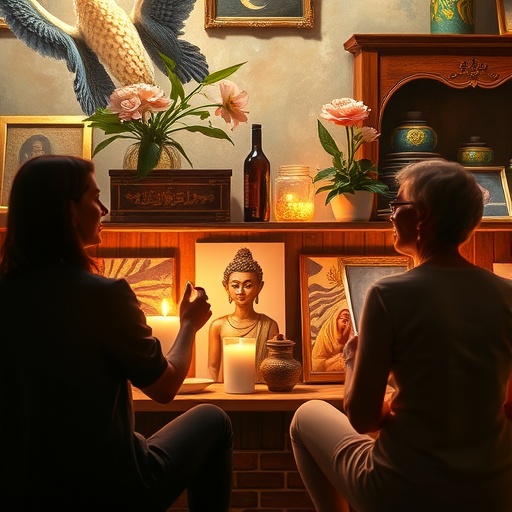The intersection of art and wellbeing has long been a subject of intrigue among researchers, policymakers, and practitioners alike. A recent study, articulated by Benison, Le, and Grimes, delves into the intricate relationship between the arts and mental health, unveiling fresh insights that could potentially recalibrate the way society perceives the significance of creative expression in enhancing life quality. In a robust examination set against the backdrop of cultural practices, the trio recommends a renewed focus on the arts as a vital component of public health strategies.
As the discussion of mental health intensifies globally, the study offers a timely contribution, emphasizing the arts not merely as a form of entertainment but as an essential avenue for fostering psychological resilience. With an emerging body of evidence linking participation in arts activities to improved emotional outcomes, this research serves as a clarion call for advocates of both fields to unite and leverage the therapeutic potential of creativity.
In their analysis, the authors employ a multifaceted lens, incorporating qualitative and quantitative metrics to paint a comprehensive picture of how the arts influence wellbeing. They recognize that wellbeing is a complex construct, influenced by various factors, including individual circumstances, social support networks, and cultural context. By anchoring their findings in empirical data, they bolster the argument that engagement in artistic endeavors provides significant benefits, such as stress reduction, enhanced mood, and increased social connection.
The research intricately dissects various forms of art—ranging from visual arts to performing arts—illustrating how each modality uniquely contributes to cultivating a sense of belonging and purpose. For instance, participating in community theater not only nurtures creativity but also fosters cooperation and camaraderie among participants. The authors argue that these communal experiences are crucial; they deepen interpersonal connections and foster a supportive environment that enhances individual and collective wellbeing.
Moreover, the study highlights that art practices can function as tools for coping with adversity. Particularly during times of crisis, whether it be personal hardships or global events such as the COVID-19 pandemic, creative expression can offer an essential outlet for processing emotions and experiences. This ability to articulate feelings through artistic mediums helps mitigate the psychological toll that such events can exert on individuals, underscoring the resilience of the human spirit.
The implications of the study’s findings extend far beyond individual outcomes; they propose that systemic changes be implemented within public health frameworks to incorporate the arts meaningfully. Health policies that embrace artistic initiatives could create vast civic benefits, leading to healthier populations marked by lower rates of anxiety and depression. The authors advocate for partnerships between healthcare institutions and local arts organizations to facilitate access to creative programs, thus enriching community health landscapes.
Importantly, the research also underscores the role of technology in democratizing access to arts experiences. Digital platforms have surged in popularity, providing new avenues for individuals to engage with the arts. The potential of virtual art galleries, online workshops, and remote performances emerged as significant assets in promoting mental health, particularly for those unable to participate in traditional settings. As society continues to grapple with shifting paradigms, the study calls for an innovative embrace of these digital spaces as integral to future cultural engagements.
Furthermore, the findings encourage an examination of demographic discrepancies in access to art-related activities. Noting that marginalized communities often encounter barriers to participation, the authors insist on the necessity to address these disparities. Ensuring equitable access to the arts is critical; it not only enriches the lives of individuals within those communities but also fosters societal inclusivity and understanding.
The study demonstrates a clear correlation between creative engagement and enhanced life satisfaction, revealing that individuals who actively partake in artistic endeavors report higher levels of happiness and fulfillment. Importantly, these findings galvanize the need for continued research to explore the depths of how the arts can serve as a preventive measure against mental health issues, particularly for vulnerable populations.
In their concluding remarks, the authors of the study invite policymakers, educators, and community leaders to recognize the urgency of their recommendations. A call to action resonates throughout the research; the integration of arts into wellbeing frameworks is not only beneficial but essential for cultivating a society that prioritizes holistic health. The arts should be viewed as a crucial pillar in strategies aimed at fostering resilience, connection, and emotional stability.
In the broader context, the study’s implications stretch across the globe, encouraging a transformative shift in how societies value and incorporate the arts within public health paradigms. The research provides a significant roadmap for future endeavors and collaborations, hinting at a world where the arts are woven into the very fabric of health and wellness strategies.
With a continuing commitment to supporting the arts, fostering creativity, and recognizing its invaluable role in promoting mental health, society can cultivate a more vibrant and resilient future. The endurance of the human spirit, nurtured through artistic expression, can stand as a testament to the profound relationship that unites wellbeing and the arts.
In conclusion, this compelling survey by Benison, Le, and Grimes captures the essence of how the arts can be a beacon of hope and healing. As the conversation around mental health evolves, it is clear that integrating artistic practices not only enhances individual quality of life but also enriches the collective human experience.
Subject of Research: The relationship between wellbeing and the arts
Article Title: Wellbeing and the Arts: A Concise Survey with New Findings
Article References:
Benison, T., Le, T. & Grimes, A. Wellbeing and the Arts: A Concise Survey with New Findings.
Applied Research Quality Life (2025). https://doi.org/10.1007/s11482-025-10508-z
Image Credits: AI Generated
DOI: 10.1007/s11482-025-10508-z
Keywords: Arts, Wellbeing, Mental Health, Community, Therapy, Creativity, Public Health, Research, Access, Digital Platforms, Resilience, Inclusion, Emotional Connection.




